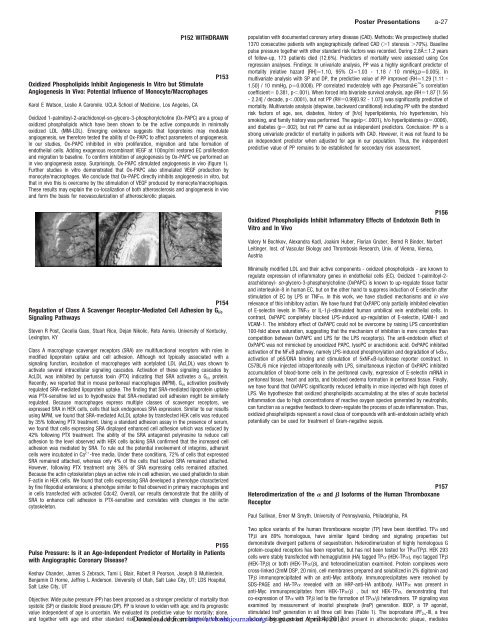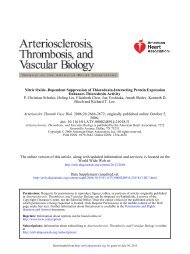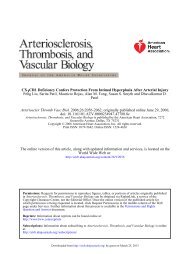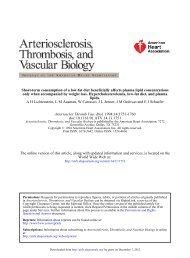Oral Presentations - Arteriosclerosis, Thrombosis, and Vascular ...
Oral Presentations - Arteriosclerosis, Thrombosis, and Vascular ...
Oral Presentations - Arteriosclerosis, Thrombosis, and Vascular ...
Create successful ePaper yourself
Turn your PDF publications into a flip-book with our unique Google optimized e-Paper software.
P152 WITHDRAWN<br />
Oxidized Phospholipids Inhibit Angiogenesis In Vitro but Stimulate<br />
Angiogenesis In Vivo: Potential Influence of Monocyte/Macrophages<br />
Karol E Watson, Leslie A Caromile. UCLA School of Medicine, Los Angeles, CA<br />
P153<br />
Oxidized 1-palmitoyl-2-arachidonoyl-sn-glycero-3-phosphorylcholine (Ox-PAPC) are a group of<br />
oxidized phospholipids which have been shown to be the active compounds in minimally<br />
oxidized LDL (MM-LDL). Emerging evidence suggests that lipoproteins may modulate<br />
angiogenesis, we therefore tested the ability of Ox-PAPC to affect parameters of angiogenesis.<br />
In our studies, Ox-PAPC inhibited in vitro proliferation, migration <strong>and</strong> tube formation of<br />
endothelial cells. Adding exogenous recombinant VEGF at 100ng/ml restored EC proliferation<br />
<strong>and</strong> migration to baseline. To confirm inhibition of angiogenesis by Ox-PAPC we performed an<br />
in vivo angiogenesis assay. Surprisingly, Ox-PAPC stimulated angiogenesis in vivo (figure 1).<br />
Further studies in vitro demonstrated that Ox-PAPC also stimulated VEGF production by<br />
monocyte/macrophages. We conclude that Ox-PAPC directly inhibits angiogenesis in vitro, but<br />
that in vivo this is overcome by the stimulation of VEGF produced by monocyte/macrophages.<br />
These results may explain the co-localization of both atherosclerosis <strong>and</strong> angiogenesis in vivo<br />
<strong>and</strong> form the basis for neovascularization of atherosclerotic plaques.<br />
P154<br />
Regulation of Class A Scavenger Receptor-Mediated Cell Adhesion by Gi/o Signaling Pathways<br />
Steven R Post, Cecelia Gass, Stuart Rice, Dejan Nikolic, Reto Asmis. University of Kentucky,<br />
Lexington, KY<br />
Class A macrophage scavenger receptors (SRA) are multifunctional receptors with roles in<br />
modified lipoprotein uptake <strong>and</strong> cell adhesion. Although not typically associated with a<br />
signaling function, incubation of macrophages with acetylated LDL (AcLDL) was shown to<br />
activate several intracellular signaling cascades. Activation of these signaling cascades by<br />
AcLDL was inhibited by pertussis toxin (PTX) indicating that SRA activates a G i/o protein.<br />
Recently, we reported that in mouse peritoneal macrophages (MPM), G i/o activation positively<br />
regulated SRA-mediated lipoprotein uptake. The finding that SRA-mediated lipoprotein uptake<br />
was PTX-sensitive led us to hypothesize that SRA-mediated cell adhesion might be similarly<br />
regulated. Because macrophages express multiple classes of scavenger receptors, we<br />
expressed SRA in HEK cells, cells that lack endogenous SRA expression. Similar to our results<br />
using MPM, we found that SRA-mediated AcLDL uptake by transfected HEK cells was reduced<br />
by 35% following PTX treatment. Using a st<strong>and</strong>ard adhesion assay in the presence of serum,<br />
we found that cells expressing SRA displayed enhanced cell adhesion which was reduced by<br />
42% following PTX treatment. The ability of the SRA antagonist polyinosine to reduce cell<br />
adhesion to the level observed with HEK cells lacking SRA confirmed that the increased cell<br />
adhesion was mediated by SRA. To rule out the potential involvement of integrins, adherant<br />
cells were incubated in Ca 2 -free media. Under these conditions, 72% of cells that expressed<br />
SRA remained attached, whereas only 4% of the cells that lacked SRA remained attached.<br />
However, following PTX treatment only 36% of SRA expressing cells remained attached.<br />
Because the actin cytoskeleton plays an active role in cell adhesion, we used phalloidin to stain<br />
F-actin in HEK cells. We found that cells expressing SRA developed a phenotype characterized<br />
by fine filopodial extensions; a phenotype similar to that observed in primary macrophages <strong>and</strong><br />
in cells transfected with activated Cdc42. Overall, our results demonstrate that the ability of<br />
SRA to enhance cell adhesion is PTX-sensitive <strong>and</strong> correlates with changes in the actin<br />
cytoskeleton.<br />
P155<br />
Pulse Pressure: Is it an Age-Independent Predictor of Mortality in Patients<br />
with Angiographic Coronary Disease?<br />
Keshav Ch<strong>and</strong>er, James S Zebrack, Tami L Blair, Robert R Pearson, Joseph B Muhlestein,<br />
Benjamin D Horne, Jeffrey L Anderson. University of Utah, Salt Lake City, UT; LDS Hospital,<br />
Salt Lake City, UT<br />
Objective: Wide pulse pressure (PP) has been proposed as a stronger predictor of mortality than<br />
systolic (SP) or diastolic blood pressure (DP). PP is known to widen with age; <strong>and</strong> its prognostic<br />
value independent of age is uncertain. We evaluated its predictive value for mortality; alone,<br />
<strong>and</strong> together with age <strong>and</strong> other st<strong>and</strong>ard riskDownloaded factors in a large, from<br />
prospectively followed<br />
http://atvb.ahajournals.org/<br />
Poster <strong>Presentations</strong> a-27<br />
population with documented coronary artery disease (CAD). Methods: We prospectively studied<br />
1370 consecutive patients with angiographically defined CAD (1 stenosis 70%). Baseline<br />
pulse pressure together with other st<strong>and</strong>ard risk factors was recorded. During 2.8Â1.2 years<br />
of follow-up, 173 patients died (12.6%). Predictors of mortality were assessed using Cox<br />
regression analyses. Findings: In univariate analysis, PP was a highly significant predictor of<br />
mortality (relative hazard [RH]1.10, 95% CI1.03 - 1.18 / 10 mmHg,p0.005). In<br />
multivariate analysis with SP <strong>and</strong> DP, the predictive value of PP improved (RH1.29 [1.11 -<br />
1.50] / 10 mmHg, p0.0008). PP correlated moderately with age (Pearson†s correlation<br />
coefficient 0.381, p.001). When forced into bivariate survival analysis, age (RH1.87 [1.56<br />
- 2.24] / decade, p.0001), but not PP (RH0.99[0.92 - 1.07]) was significantly predictive of<br />
mortality. Multivariate analysis (stepwise, backward conditional) including PP with the st<strong>and</strong>ard<br />
risk factors of age, sex, diabetes, history of [h/o] hyperlipidemia, h/o hypertension, h/o<br />
smoking, <strong>and</strong> family history was performed. The age(p.0001), h/o hyperlipidemia (p.0006),<br />
<strong>and</strong> diabetes (p.002), but not PP came out as independent predictors. Conclusion: PP is a<br />
strong univariate predictor of mortality in patients with CAD. However, it was not found to be<br />
an independent predictor when adjusted for age in our population. Thus, the independent<br />
predictive value of PP remains to be established for secondary risk assessment.<br />
P156<br />
Oxidized Phospholipids Inhibit Inflammatory Effects of Endotoxin Both In<br />
Vitro <strong>and</strong> In Vivo<br />
Valery N Bochkov, Alex<strong>and</strong>ra Kadl, Joakim Huber, Florian Gruber, Bernd R Binder, Norbert<br />
Leitinger. Inst. of <strong>Vascular</strong> Biology <strong>and</strong> <strong>Thrombosis</strong> Research, Univ. of Vienna, Vienna,<br />
Austria<br />
Minimally modified LDL <strong>and</strong> their active components - oxidized phospholipids - are known to<br />
regulate expression of inflammatory genes in endothelial cells (EC). Oxidized 1-palmitoyl-2arachidonoyl-<br />
sn-glycero-3-phosphorylcholine (OxPAPC) is known to up-regulate tissue factor<br />
<strong>and</strong> interleukin-8 in human EC, but on the other h<strong>and</strong> to suppress induction of E-selectin after<br />
stimulation of EC by LPS or TNF. In this work, we have studied mechanisms <strong>and</strong> in vivo<br />
relevance of this inhibitory action. We have found that OxPAPC only partially inhibited elevation<br />
of E-selectin levels in TNF or IL-1-stimulated human umbilical vein endothelial cells. In<br />
contrast, OxPAPC completely blocked LPS-induced up-regulation of E-selectin, ICAM-1 <strong>and</strong><br />
VCAM-1. The inhibitory effect of OxPAPC could not be overcome by raising LPS concentration<br />
100-fold above saturation, suggesting that the mechanism of inhibition is more complex than<br />
competition between OxPAPC <strong>and</strong> LPS for the LPS receptor(s). The anti-endotoxin effect of<br />
OxPAPC was not mimicked by unoxidized PAPC, lysoPC or arachidonic acid. OxPAPC inhibited<br />
activation of the NFB pathway, namely LPS-induced phosphorylation <strong>and</strong> degradation of IB,<br />
activation of p65/DNA binding <strong>and</strong> stimulation of 5xNFB-luciferase reporter construct. In<br />
C57BL/6 mice injected intraperitoneally with LPS, simultaneous injection of OxPAPC inhibited<br />
accumulation of blood-borne cells in the peritoneal cavity, expression of E-selectin mRNA in<br />
peritoneal tissue, heart <strong>and</strong> aorta, <strong>and</strong> blocked oedema formation in peritoneal tissue. Finally,<br />
we have found that OxPAPC significantly reduced lethality in mice injected with high doses of<br />
LPS. We hypothesize that oxidized phospholipids accumulating at the sites of acute bacterial<br />
inflammation due to high concentrations of reactive oxygen species generated by neutrophils,<br />
can function as a negative feedback to down-regulate the process of acute inflammation. Thus,<br />
oxidized phospholipids represent a novel class of compounds with anti-endotoxin activity which<br />
potentially can be used for treatment of Gram-negative sepsis.<br />
P157<br />
Heterodimerization of the <strong>and</strong> Isoforms of the Human Thromboxane<br />
Receptor<br />
Paul Sullivan, Emer M Smyth. University of Pennsylvania, Philadelphia, PA<br />
Two splice variants of the human thromboxane receptor (TP) have been identified. TP <strong>and</strong><br />
TP are 89% homologous, have similar lig<strong>and</strong> binding <strong>and</strong> signaling properties but<br />
demonstrate divergent patterns of sequestration. Heterodimerization of highly homologous G<br />
protein-coupled receptors has been reported, but has not been tested for TP/TP. HEK 293<br />
cells were stably transfected with hemagglutinin (HA) tagged TP (HEK-TP), myc tagged TP<br />
(HEK-TP) or both (HEK-TP/), <strong>and</strong> heterodimerization examined. Protein complexes were<br />
cross-linked (2mM DSP, 20 min), cell membranes prepared <strong>and</strong> solubilized in 2% digitonin <strong>and</strong><br />
TP immunoprecipitated with an anti-Myc antibody. Immunoprecipitates were resolved by<br />
SDS-PAGE <strong>and</strong> HA-TP revealed with an HRP-anti-HA antibody. HATP was present in<br />
anti-Myc immunoprecipitates from HEK-TP/ , but not HEK-TP, demonstrating that<br />
co-expression of TP with TP led to the formation of TP/ heterodimers. TP signaling was<br />
examined by measurement of inositol phosphate (InsP) generation. IBOP, a TP agonist,<br />
stimulated InsP generation in all three cell lines (Table 1). The isoprostane iPF2-III, a free<br />
radical catalyzed by guest product on April of arachidonic 4, 2013 acid present in atherosclerotic plaque, mediates














